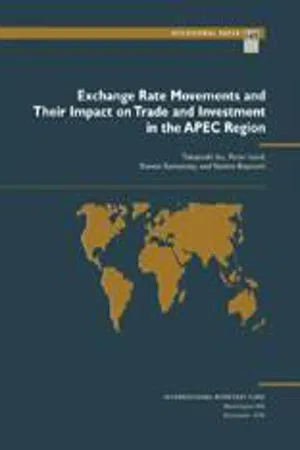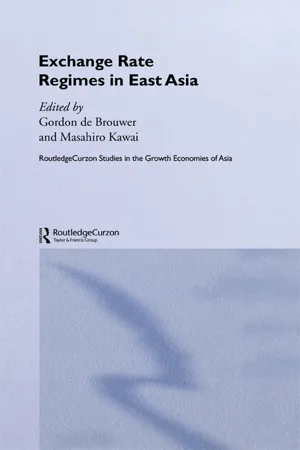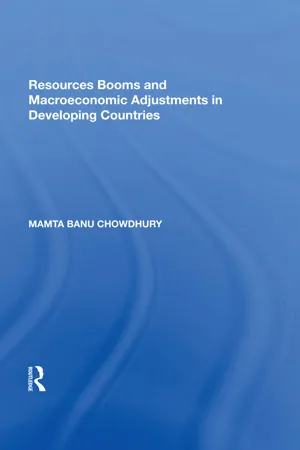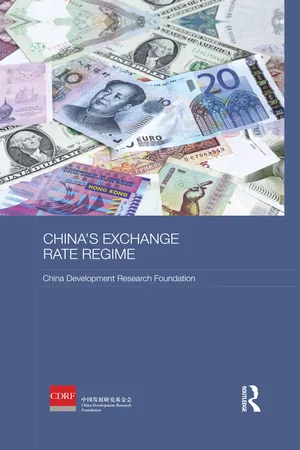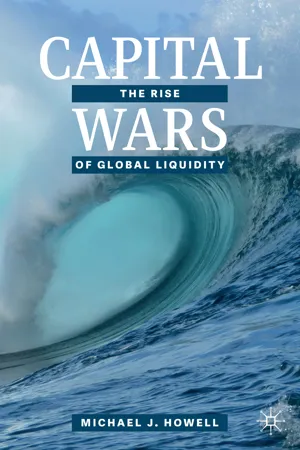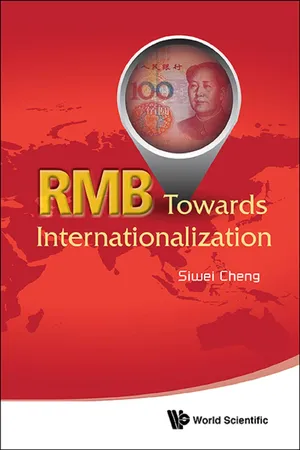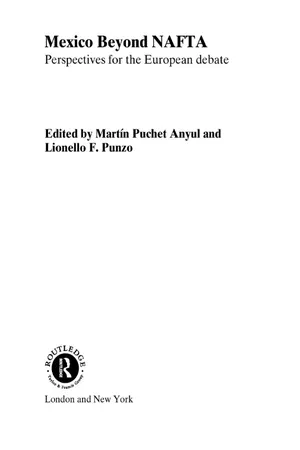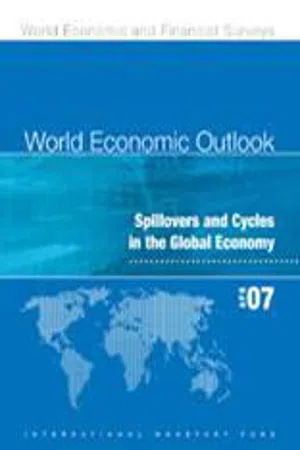Economics
Real Exchange Rate
The real exchange rate is the nominal exchange rate adjusted for price level differences between two countries. It reflects the relative purchasing power of two currencies and is used to compare the cost of goods and services between countries. A higher real exchange rate means a country's goods and services are relatively more expensive compared to another country.
Written by Perlego with AI-assistance
Related key terms
10 Key excerpts on "Real Exchange Rate"
- Takatoshi Ito, Tamim Bayoumi, Peter Isard, and Steven Symansky(Authors)
- 1996(Publication Date)
- INTERNATIONAL MONETARY FUND(Publisher)
III. International Trade and Real Exchange Rates
Tamim BayoumiThe Real Exchange Rate is one of the key relative prices in an economy, defining the rate of exchange between domestic goods and their foreign counterparts. As a result, changes in the exchange rate have economy-wide implications that are communicated largely through international trade. The effects of exchange rate changes on the economy are particularly important for the APEC region because the exchange rates of its two largest members, the United States and Japan, have experienced large deviations from trend over the past twenty years. The appreciation and subsequent depreciation of the U.S. dollar over the mid-1980s had a significant impact on regional trade linkages, as has the appreciation of the yen since 1993.In looking at the relationship between Real Exchange Rates (defined as the relative price of goods in different countries) and trade, it is useful to distinguish between the effects of day-to-day exchange rate volatility and more persistent movements in the exchange rate. The breakup of the Bretton Woods fixed exchange rate system in the early 1970s led to the general adoption of floating exchange rates. One consequence of this shift was a marked increase in the level of exchange rate volatility, with day-to-day and month-to-month movements in the exchange rate becoming much larger. For example, the standard deviation of monthly changes in the exchange rate between the yen and the dollar after 1973 has been over triple the value between 1962 and 1972 (Mussa and others, 1994 , Table 2). In addition to this short-term volatility, there have also been more persistent deviations of Real Exchange Rates from long-term trends. The most obvious cases are those mentioned earlier: the appreciation and depreciation of the dollar in the mid-1980s and the more recent appreciation of the yen.This section assesses the impact of both types of exchange rate behavior on trade within the APEC region. The focus will be largely on the impact of medium-term changes in the exchange rate. There is strong evidence that such movements have significant effects on trade; empirical trade equations consistently have found that the Real Exchange Rate is one of the key determinants of both exports and imports. In addition to reviewing the relevant literature, some new estimates of the impact of such exchange rate changes on trade volumes will be presented.- eBook - ePub
- Masahiro Kawai, Gordon de Brouwer(Authors)
- 2004(Publication Date)
- Routledge(Publisher)
10 Measuring real effective exchange rates
Menzie D. ChinnINTRODUCTION
Economists and policymakers often refer to the exchange rate as a key macroeconomic variable. As a relative price, the exchange rate plays a crucial role in theoretical models of the open economy and transactions between countries. However, the link between the theoretical concept of the exchange rate and its empirical application is not straightforward. This chapter lays out the chief concerns the analyst must confront when determining which empirical measure of the exchange rate to use.The issue has taken on heightened importance in recent years, as the scope of international transactions has expanded and more and more economic activity is either directly or indirectly affected by economic activity in other countries. While it is commonplace to think of such transactions as being primarily in the domain of trade in goods and, increasingly, services, this presumption is probably not completely justified. Part of the process that is popularly known as ‘globalisation’ entails increasing trade in assets, so one would also like to know what, if any, relative price is relevant for capital flows or stocks.In this chapter, I examine the question of the appropriate ‘real effective exchange rate’ to use, in the following manner. First, I discuss in what cases a particular definition of the Real Exchange Rate is appropriate. Second, I take up the issue of selecting the criteria determining the ‘effective’ aspect. This question essentially reduces to one of what weights should be placed on each interacting partner country. Then I compare the behaviour of differing Real Exchange Rate indices along different dimensions, such as the use of price deflators, and differing weighting schemes. Finally, I demonstrate the utility of these real effective exchange rates by way of several applications to current policy issues. - Mamta Banu Chowdhury(Author)
- 2017(Publication Date)
- Routledge(Publisher)
Chapter 2 . A more restricted trade regime would worsen the situation by increasing demand for and price of semi-traded and import substitutes, since they behave as nontradables and their prices are determined by domestic demand and supply conditions during the boom years.The model predicts that an expansionary macro policy associated with domestic money creation would widen the current account deficit, deplete international reserves and cause a RER appreciation. A restrictive wage and income policy can slowdown the appreciation of the RER by reducing demand for and price of nontradables. A change in the nominal exchange rate can help to restore the misaligned Real Exchange Rate towards its equilibrium value. A nominal devaluation helps to prevent erosion of competitiveness in the export sector by reducing the foreign currency price of exports in the world market. The effectiveness of a change in the nominal exchange rate correcting a misaligned Real Exchange Rate would be more powerful and long lasting if they are accompanied by appropriate macroeconomic policies. These two assumptions of nominal determinants of the Real Exchange Rate portray most of the stylised features of macroeconomic policy options available for a small open developing economy such as PNG to correct a misalignment of the Real Exchange Rate.4.6 Variable Definition and MeasurementThe Real Exchange Rate model in equation (4.23) is estimated over the sample period 1970-1994 using annual data. In this section, data sources are listed and the method of data transformation adopted and its key limitations are discussed. All variables, except net capital inflow, are measured in natural logarithms.The Real Exchange Rate series presented in Tables 4.1 and 4.2 have been constructed from the available secondary data sources in the absence of ready-made data for the key dependent variable, the Real Exchange Rate (log et ). The explanatory variables are extracted from a variety of sources including The World Bank, World Tables , IMF, International Financial Statistics , Bank of PNG, Quarterly Economic Bulletin- eBook - ePub
- China Development Research Foundation(Author)
- 2014(Publication Date)
- Routledge(Publisher)
5Evaluating the ‘real equilibrium exchange rate’ of the RMBLi Shantong 1Introduction
In an open economy, exchange rates represent the ‘overall price’ of one country’s goods, services, and assets, relative to the overall price of another country’s goods, services, and assets. The degree to which a country’s overall price is in ‘equilibrium’ provides a fundamental basis for economic policy. Determinations of exchange-rate equilibrium, and the degree to which exchange rates are out of line, enable the formulation of domestic policy as well as coordinated international adjustments. Given the globalization of economies, determinations of what equilibrium really is, or should be, also involve a complex kind of economic gamesmanship. Both international economics and politics are involved. As China’s position has gradually risen amid the world’s economies, a determination of the ‘real, equilibrium exchange-rate level’ is highly significant. A realistic determination not only benefits China, by creating an international environment that is beneficial to its own development, but it helps promote world economic development as well.In July, 2005, China began to implement an exchange-rate system that was described as a ‘managed float, based on market supply and demand, with adjustments made in reference to a basket of currencies.’ Despite the international financial crisis which erupted in the second half of 2008, the RMB to US dollar exchange rate fluctuated within a narrow band, while the ‘real, effective exchange rate’ first rose, and then fell. Between July of 2005, when exchange-rate reform was initiated, and September of 2010, the RMB had appreciated against the US dollar by 23 percent, while the real effective exchange rate had appreciated by 19 percent. Now, given the current global situation, we should begin to address several questions. In the five years since exchange-rate reform, has the RMB reached levels that are reasonable and appropriate? Is the RMB exchange-rate in balance, or not? If misaligned, what is the degree of that misalignment? Finally, for the near term, from 2010 to 2015, what range of exchange rates for the RMB would be reasonable? The primary purpose of this chapter is to address these questions. - eBook - ePub
Capital Wars
The Rise of Global Liquidity
- Michael J. Howell(Author)
- 2020(Publication Date)
- Palgrave Macmillan(Publisher)
In the US it averaged 1.0% per annum; in Japan 0.7%; Korea 2.0% and in China 6.1%. Figure 5.1 highlights the secular decline in the US real trade-weighted exchange rate, as calculated by the BIS (Bank for International Settlements). Fitting a trend line to the data prior to 2016, shows the real US dollar losing roughly ten index points in value each decade, or circa 8%. We have added annotations to describe the three periods (explained in Chapter 1) when a greater demand for dollars halted this slide and allowed the US terms of trade to temporarily improve, sometimes surging by as much as 20% above its downward trend. Latest data since 2016 lends weight to an argument that this long downtrend in relative productivity performance may have ended. While this is possible, the counterargument notes China’s still yawning absolute productivity gap with America. A graph for the U S dollar real trade weighted exchange rate index and policy regimes for the period from 1964 to 2019. The three peaks on the graph are for, Bretton woods and gold exchange, oil exchange, and emerging market exchange, respectively. Fig. 5.1 US dollar real trade-weighted exchange rate index, 10-year trend and policy regimes, 1964–2019 (Source BIS and CrossBorder Capital) The Real Exchange Rate can be calculated by adjusting the nominal exchange rate for relative price movements, but what exactly comprises these baskets of prices is less straightforward. We take a broad definition that includes traded and non-traded goods and service prices, wages, and asset prices. The degree of flexibility exhibited by these various price types differs considerably. It seems plausible that, in a World economy dominated by large global businesses, asset prices are among the most flexible and traded goods and service prices among the least flexible. There is supporting evidence that shows how prices tend to be rigid in the currency in which they are invoiced (see Gopinath et al. 2018) - eBook - ePub
- Siwei Cheng(Author)
- 2015(Publication Date)
- WSPC(Publisher)
PPP theory holds that the exchange rate between different countries is decided by the ratio of their price levels, which can be expressed as the composite price index of a basket of goods and services. The price level in a country reflects the purchasing power of that country’s issued currency. Therefore, exchange rates can be understood as the ratio between the two currencies’ purchasing powers in their corresponding countries. When a currency’s purchasing power decreases (for instance, when currency inflation occurs) the exchange rate of its currency will decrease (as expressed in an indirect quotation on a foreign exchange). To put it simply, people’s demand for domestic and foreign currency fundamentally result from their demand for domestic goods, foreign goods, and/or labor. In essence people’s demands for different currencies can be understood as an expression of their demand for the purchasing power of a currency, and currency exchange is in fact the exchange of different currencies’ purchasing powers. Based on this understanding, the ratio between different currencies, or the exchange rate, can be expressed by a purchasing power calculation — the PPP.PPP can be divided into Absolute PPP in its static form and Relative PPP in its dynamic form. Absolute PPP is the exchange rate as determined by two countries’ total price levels in a specified time. Its formula is:In this formula P* stands for the foreign commodity prices, P stands for the domestic commodity prices, E stands for the nominal exchange rate, e stands for Real Exchange Rate.Relative PPP is a dynamic form that incorporates inflation into its calculation. It is the change of exchange rate in a specified period, where the difference between the two countries’ inflation rates determines the rate’s movement. The formula is:e′ = p − p*.In this formula e′ stands for the rates of exchange rate changes, p − p* stands for the Inflation rate differential between the two countries. It means that from the relative PPP theory perspective, the rate of change of the exchange rate is equal to the inflation rate difference between the two countries.Figure 2.1: Comparison of Nominal RMB Exchange Rate and PPP-derived RMB Exchange Rate1PPP theory has been criticized for its many limitations. Figure 2.1 - eBook - ePub
- Martin Puchet Anyul, Lionello F Punzo(Authors)
- 2001(Publication Date)
- Routledge(Publisher)
e in equation (3).In the case we are analyzing, we have included the level of real national income as a variable that has had these two important effects on the Real Exchange Rate. But considering the various exchange rate policies followed, the dynamics of exports and the inflow of short-term capital, during the period, we expect the relationship to be positive.Thus, the Real Exchange Rate is determined by relative unit labor costs and real national income. This proposition is formulated in the following equation:where, E = Real Exchange Rate index dollars/pesos, U = relative unit labor costs index, Mex/US, Y = GDP of Mexico.Equation (4) was estimated by econometric techniques, and the procedure and results are presented in the Appendix. The estimation shows that relative unit labor costs determine the trend for the Real Exchange Rate. The main determining variable in the long run is relative unit labor costs while the other variable determines the variations around it. It was also found that the relation is not linear. Relative unit labor costs act as center of gravity of the Real Exchange Rate, in the long run.4.2.4 Some implications for policy
A nominal depreciation of the currency by itself does not necessarily imply a real depreciation, since a depreciation produces a short-run domestic inflation which offsets its effect on the real rate. In that case a real depreciation can only be produced by a reduction of unit labor costs. These, in turn, have two determinants: wages and productivity. Thus, in order to reduce unit labor costs, either the real wage rate is to be reduced or productivity raised, or both. Moreover, this has to be done at a faster rate than the country’s main competitor(s) in the world market, so as to improve the country’s competitive position. - eBook - ePub
- Anthony J. Makin(Author)
- 2016(Publication Date)
- Routledge(Publisher)
3 The exchange rate and competitiveness The classical British economist and political philosopher John Stuart Mill (1848) observed during the gold standard era that:So much barbarism, however, still remains in the transactions of most civilized nations, that almost all independent countries choose to assert their nationality by having, to their own inconvenience and their neighbour’s, a peculiar currency of their own.This inconvenience arises because each nation or region produces its own kind of money which has to be exchanged for other moneys. Some examples are dollars, euro, yuan, yen, pounds, pesos and dong. Not only does the existence of so many monies complicate cross-border economic transactions, it adds another dimension to analysing monetary economies.The exchange rate is arguably the single most important variable in international finance as it sets the prices at which an open economy trades goods, services and assets in domestic and world markets. For this reason, sharp exchange rate movements make economic ‘news’. This chapter outlines the different systems under which exchange rates are set and their fundamental determinants.Since the exchange rate is a price – the price of one currency in terms of another – just like other price changes, exchange rate movements alter economic welfare. The widespread interest in large exchange rate movements is understandable since those affected by such fluctuations include all consumers and producers of internationally traded goods and services, producers who compete with internationally traded goods and services, and those domestic enterprises with assets and liabilities denominated in foreign currencies.Exchange rate systemsThe choice of exchange rate regime is one of the most significant macroeconomic policy decisions any national government must make, yet a range of different exchange rate arrangements characterise the international monetary system. This suggests that the type of exchange rate regime suited to one particular economy may not be the best for another. - eBook - ePub
From Trade Surplus To The Dispute Over The Exchange Rate: Quantitative Analysis Of Rmb Appreciation
Quantitative Analysis of RMB Appreciation
- Xin Li, Dianqing Xu(Authors)
- 2016(Publication Date)
- WSPC(Publisher)
Disequilibrium is absolute, whereas equilibrium is relative in the world. In economics research, people often use equilibrium price as the frame of reference. The price is slightly high if it is higher than the equilibrium price or slightly low if it is lower than the equilibrium price. In discussions on whether the RMB exchange rate is high or low, people usually refer to the equilibrium exchange. Those who accuse China of manipulating the exchange rate contend that the RMB exchange rate is lower than the equilibrium exchange rate, and thus the RMB exchange rate is undervalued.What is the equilibrium exchange rate? Our review of papers that calculated the equilibrium exchange rate in recent years reveals that calculations are of four types: (1)Calculating an “equilibrium rate” to realize the internal equilibrium: domestic prices and employment are kept stable. (2)Calculating an “equilibrium rate” to realize the external equilibrium: the current account surplus reaches the sustainable level, and the international payment is maintained to be balanced. (3)Calculating an “equilibrium rate” so that all countries involved in trade cannot improve their welfare through adjusting the exchange rate without harming other participants.(4)Calculating an “equilibrium rate” to keep the ratios of the current accounts to the GDP in different countries within a certain range. This approach is usually called trade weighted.1The goal determines the path. Although everyone refers to the equilibrium exchange rate, their connotations are different. The equilibrium exchange rates above correspond to different goals so the results are different.The equilibrium exchange rate can be calculated using three methods: The Extension Purchasing Power Parity (EPPP), The Fundamental Equilibrium Exchange Rate (FEER) and the Behavioral Equilibrium Exchange Rate (BEER).The EPPP holds that if the Real Exchange Rate is a stationary time series, the long-term equilibrium exchange rate can be calculated with the relative PPP. Aside from the per-capita income and labor productivity, the EPPP model includes a number of variables that may affect the Real Exchange Rate, such as net foreign assets, domestic investment, economic growth rate, openness, trade conditions, and so on. Clearly, for a country in a period of economic transition or take-off, if the Real Exchange Rate is not a stationary and continuous time series, the PPP is useless. - International Monetary Fund. Research Dept.(Author)
- 2006(Publication Date)
- INTERNATIONAL MONETARY FUND(Publisher)
This finding carries important implications for the role of exchange rate movements in external adjustment. As entry and exit into export markets require firms to sustain fixed costs, only large and persistent changes in relative prices may induce firms to incur such costs—consistent with the evidence of nonlin-earities in trade responsiveness discussed above. Moreover, more flexible production structures (that is, with lower fixed costs of entry and exit) could help firms take advantage of new opportunities when relative prices change permanently, and thus enhance a country’s aggregate trade responsiveness to exchange rate movements.Two pieces of evidence point to a correlation between the effectiveness of Real Exchange Rates and economic flexibility. First, there is a negative correlation between the thresholds in relative price changes found in the nonlinear model of trade volumes described above and an index of flexibility of product and labor markets (Figure 3.9 ).24 This suggests that relative prices may need to change less to generate a faster adjustment of trade volumes in countries in which labor and product market rigidities are smaller. Second, separating the reversal episodes analyzed earlier based on the degree of flexibility of the economies in which they occurred suggests that changes in real effective exchange rates during adjustment have been smaller in relatively more flexible economies. Moreover, the negative trade-off between total Real Exchange Rate depreciation and the average change in GDP after the reversal is found only for the more flexible economies, suggesting that only for them have the exchange rate movements been effective in cushioning (other things being equal) the output costs associated with adjustment (see Figure 3.9 ).Figure 3.9 . Thresholds in Relative Trade Prices, Real Effective Exchange Rate, and Flexibility of MarketsCountries with higher values of the flexibility index tend to have lower thresholds in the growth rate of relative prices of imports and exports. More flexible economies have experienced smaller movements in real effective exchange rate (REER) during reversal episodes. Only for these economies does there appear to be a trade-off between REER depreciation and GDP growth during deficit reversals.
Index pages curate the most relevant extracts from our library of academic textbooks. They’ve been created using an in-house natural language model (NLM), each adding context and meaning to key research topics.
